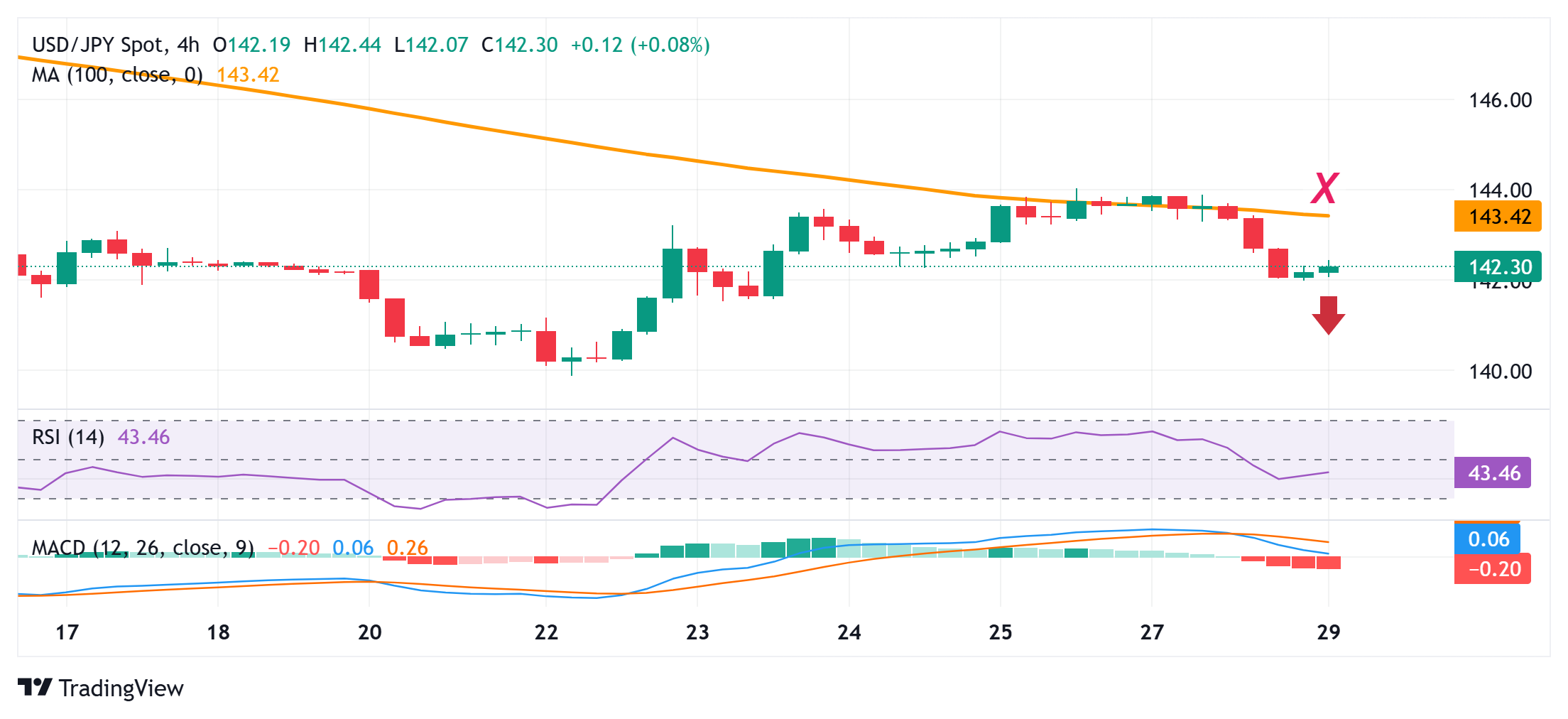Created
: 2025.04.29














![]() 2025.04.29 11:23
2025.04.29 11:23
The Japanese Yen (JPY) ticks lower during the Asian session on Tuesday and erodes a part of the previous day's strong recovery gains from a two-week low against its American counterpart. The overall market mood remains cautiously optimistic amid signs of easing trade tensions between the US and China - the world's two largest economies - and hopes that the US will start to announce some trade deals. This, in turn, is seen undermining traditional safe-haven assets, including the JPY, though traders seem reluctant to place aggressive directional bets ahead of the Bank of Japan (BoJ) policy meeting this week.
The Japanese central bank is scheduled to announce its decision on Thursday and is expected to keep interest rates steady amid heightening risks to the fragile economy from US tariffs. However, signs of broadening inflation in Japan keep the door open for further policy tightening by the BoJ. Moreover, persistent geopolitical tensions and US President Donald Trump's rapidly shifting stance on trade policies keep investors on the edge, which might limit JPY losses. Furthermore, the underlying bearish sentiment surrounding the US Dollar (USD) should contribute to capping any meaningful gains for the USD/JPY pair.

From a technical perspective, the USD/JPY pair struggled to find acceptance above the 100-period Simple Moving Average (SMA) on the 4-hour chart and faced rejection near the 144.00 mark. Given that oscillators are holding in negative territory on daily and hourly charts, some follow-through selling below the 142.00 round figure will be seen as a fresh trigger for bearish traders. Spot prices might then accelerate the fall towards the mid-141.00s en route to the 141.10-141.00 region. The downward trajectory could extend further towards intermediate support near the 140.50 area and eventually expose the multi-month low - levels below the 140.00 psychological mark touched last week.
On the flip side, the immediate hurdle is pegged near the 142.60-142.65 region, above which a bout of a short-covering could lift the USD/JPY pair to the 143.00 mark en route to the next relevant resistance near the 143.40-143.45 zone. Some follow-through buying should allow spot prices to conquer the 144.00 round figure. A sustained strength and acceptance above the latter would suggest that the pair has formed a near-term bottom and pave the way for some meaningful upside.
The Japanese Yen (JPY) is one of the world's most traded currencies. Its value is broadly determined by the performance of the Japanese economy, but more specifically by the Bank of Japan's policy, the differential between Japanese and US bond yields, or risk sentiment among traders, among other factors.
One of the Bank of Japan's mandates is currency control, so its moves are key for the Yen. The BoJ has directly intervened in currency markets sometimes, generally to lower the value of the Yen, although it refrains from doing it often due to political concerns of its main trading partners. The BoJ ultra-loose monetary policy between 2013 and 2024 caused the Yen to depreciate against its main currency peers due to an increasing policy divergence between the Bank of Japan and other main central banks. More recently, the gradually unwinding of this ultra-loose policy has given some support to the Yen.
Over the last decade, the BoJ's stance of sticking to ultra-loose monetary policy has led to a widening policy divergence with other central banks, particularly with the US Federal Reserve. This supported a widening of the differential between the 10-year US and Japanese bonds, which favored the US Dollar against the Japanese Yen. The BoJ decision in 2024 to gradually abandon the ultra-loose policy, coupled with interest-rate cuts in other major central banks, is narrowing this differential.
The Japanese Yen is often seen as a safe-haven investment. This means that in times of market stress, investors are more likely to put their money in the Japanese currency due to its supposed reliability and stability. Turbulent times are likely to strengthen the Yen's value against other currencies seen as more risky to invest in.
![]()
Created
: 2025.04.29
![]()
Last updated
: 2025.04.29

FXStreet is a forex information website, delivering market analysis and news articles 24/7.
It features a number of articles contributed by well-known analysts, in addition to the ones by its editorial team.
Founded in 2000 by Francesc Riverola, a Spanish economist, it has grown to become a world-renowned information website.
We hope you find this article useful. Any comments or suggestions will be greatly appreciated.
We are also looking for writers with extensive experience in forex and crypto to join us.
please contact us at [email protected].
Disclaimer:
All information and content provided on this website is provided for informational purposes only and is not intended to solicit any investment. Although all efforts are made in order to ensure that the information is correct, no guarantee is provided for the accuracy of any content on this website. Any decision made shall be the responsibility of the investor and Myforex does not take any responsibility whatsoever regarding the use of any information provided herein.
The content provided on this website belongs to Myforex and, where stated, the relevant licensors. All rights are reserved by Myforex and the relevant licensors, and no content of this website, whether in full or in part, shall be copied or displayed elsewhere without the explicit written permission of the relevant copyright holder. If you wish to use any part of the content provided on this website, please ensure that you contact Myforex.
Myforex uses cookies to improve the convenience and functionality of this website. This website may include cookies not only by us but also by third parties (advertisers, log analysts, etc.) for the purpose of tracking the activities of users. Cookie policy